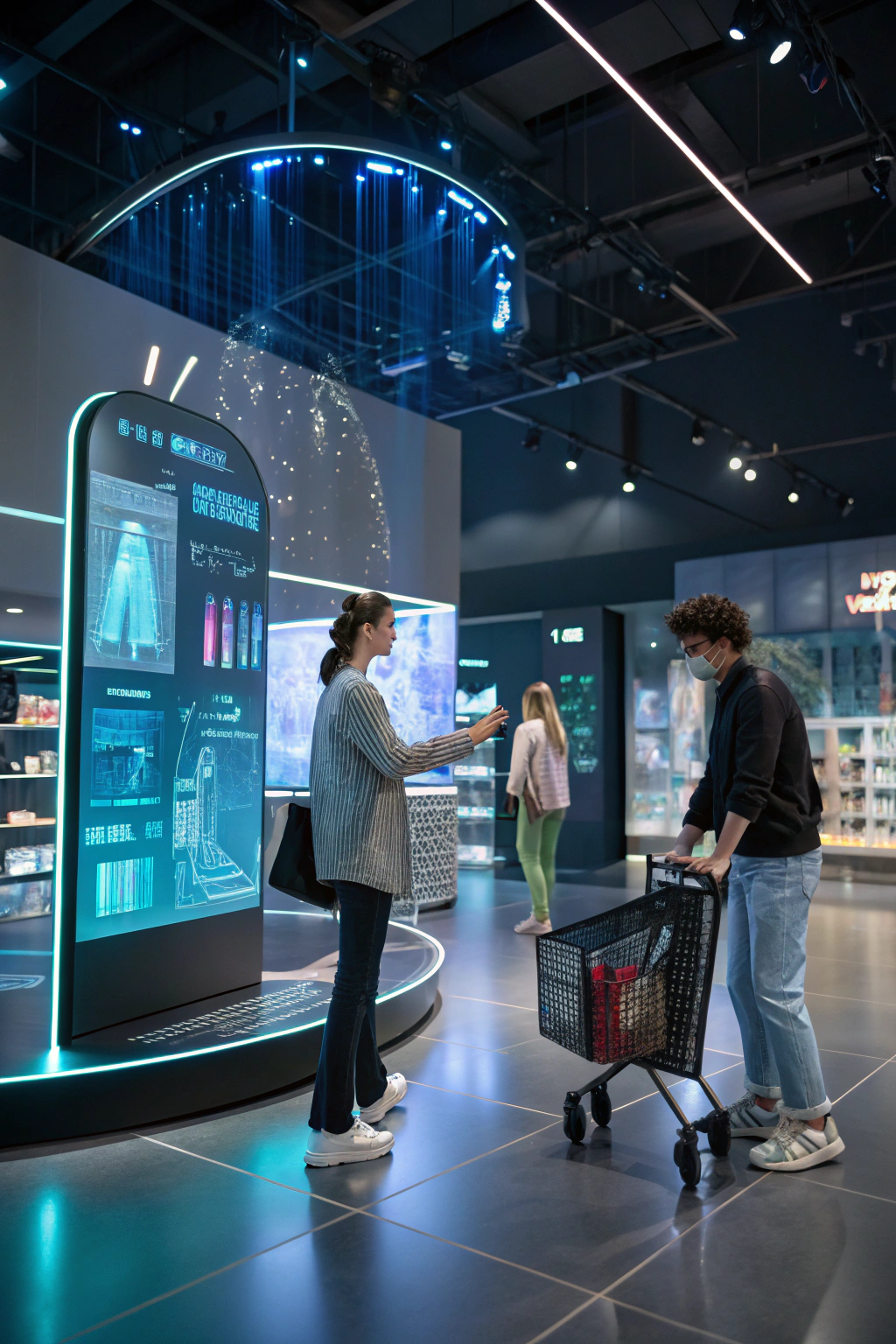Introduction
The line between our physical and digital lives is blurring faster than ever. As we step into more immersive online environments, the very fabric of commerce is being rewoven. We’re moving beyond simple e-commerce websites and into dynamic, intelligent, and persistent virtual spaces. This evolution is powered by a groundbreaking synergy of technologies, birthing a new paradigm: AI Retail: Next-Gen Commerce in Virtual Worlds. This isn’t just about recreating a shopping mall online; it’s about leveraging artificial intelligence to build personalized, interactive, and deeply engaging retail experiences that were previously the domain of science fiction.
Background and Evolution of AI Retail: Next-Gen Commerce in Virtual Worlds
The journey to our current state began with basic online catalogs in the 90s, evolving into the sophisticated e-commerce giants we know today, like Amazon and Shopify. These platforms mastered data-driven recommendations and streamlined logistics. However, the experience remained largely two-dimensional. The metaverse concept, a collective virtual shared space, promised something more. As described by visionaries, the metaverse is the next evolution of the internet, a persistent universe where we can work, play, and socialize. By infusing this space with artificial intelligence, we unlock the potential for truly responsive and intelligent retail environments, creating the foundation for next-gen commerce in virtual worlds.
Practical Applications of AI Retail: Next-Gen Commerce in Virtual Worlds
The theoretical concepts are rapidly turning into tangible applications, reshaping how brands connect with consumers. Here are a few ways this convergence is already making an impact.
Use Case 1: The Hyper-Personalized AI Shopping Assistant
Imagine entering a virtual Gucci or Nike store not as a generic visitor, but with an AI-powered personal shopper that already knows your style preferences, purchase history, and even your saved items from other platforms. This AI assistant, represented as a sophisticated avatar, can guide you through the store, suggest outfits that complement items you already own (both physical and digital), and show you how a new digital asset would look on your personal avatar in real-time. This level of service transforms shopping from a transaction into a curated experience.
Use Case 2: Dynamic and Responsive Virtual Storefronts
In the physical world, a store’s layout is static. In the metaverse, it doesn’t have to be. AI can dynamically reconfigure a virtual store’s design, product placement, and even ambient lighting based on the individual user’s profile or real-time data. For a user known to be interested in sustainable fashion, the store could highlight an eco-friendly collection upon entry. For another, it might showcase the latest high-tech sneaker release. This makes every visit unique and highly relevant, a key tenet of AI Retail: Next-Gen Commerce in Virtual Worlds.
Use Case 3: AI-Enhanced Product Co-Creation
The next frontier of personalization is co-creation. Brands can use AI-driven tools within their virtual worlds to allow customers to design their own products. An automotive brand like Ferrari could let a user customize a car in a virtual showroom, with an AI providing real-time feedback on performance implications and aesthetic pairings. Similarly, a furniture brand could use AI to help a customer design a piece of furniture that perfectly fits the dimensions and style of their real-world (or virtual) home, visualized instantly through AR/VR.
Challenges and Ethical Considerations
This powerful new model of commerce is not without its hurdles. Data privacy is a paramount concern. The sheer volume of behavioral and biometric data collected in these immersive environments to power AI personalization is unprecedented, creating new vulnerabilities. AI bias is another significant risk; if training data is flawed, AI shopping assistants could perpetuate stereotypes or create exclusionary experiences. Furthermore, the digital divide could widen, leaving those without access to high-speed internet or capable hardware behind. Establishing clear regulations around digital asset ownership, consumer protection, and data ethics is crucial for the healthy growth of this ecosystem.
What’s Next for AI Retail: Next-Gen Commerce in Virtual Worlds?
The future looks even more integrated. In the short term, we’ll see more brands launching polished virtual pop-ups on platforms like Roblox and Decentraland. Mid-term, expect deeper integration with Web3 technologies, where digital ownership is verified on the blockchain and NFTs grant access to exclusive products or experiences (token-gated commerce). Long-term, the vision is a seamless « phygital » reality where our digital avatars and assets have real-world utility, and AI manages the complex interplay between our physical and virtual inventories. Startups like Emperia and Obsess are already leading the way, building the immersive storefronts that major brands are using to dip their toes into this new retail dimension.
How to Get Involved
Diving into this new world is more accessible than you might think. Start by creating an avatar on a platform like Ready Player Me, which can be used across hundreds of different virtual experiences. Explore virtual worlds like Decentraland or Somnium Space directly from your browser to see what brands are building. For developers and entrepreneurs, engaging with communities on Discord and X (formerly Twitter) dedicated to the metaverse and AI is essential. To stay ahead of the curve on all things digital innovation, you can find a wealth of information at our hub of tech resources.
Debunking Common Myths
Several misconceptions surround this emerging field. Let’s clear a few up.
Myth 1: It’s only for gamers. While gaming paved the way, virtual worlds are now used for concerts (Fortnite), fashion shows (Decentraland Fashion Week), and social gatherings. Commerce is a natural extension of these social activities.
Myth 2: You need an expensive VR headset. False. The vast majority of today’s metaverse platforms are accessible via a standard web browser or a downloadable desktop client, removing a major barrier to entry.
Myth 3: This is just another tech fad. With billions invested by Meta, Microsoft, Google, and countless fashion, automotive, and CPG brands, the corporate commitment signals a long-term strategic shift, not a fleeting trend. The core concept of AI Retail: Next-Gen Commerce in Virtual Worlds is a foundational part of this shift.
Top Tools & Resources for AI Retail: Next-Gen Commerce in Virtual Worlds
- NVIDIA Omniverse: A powerful platform for developers and enterprises to build and operate metaverse applications. It provides the tools for creating physically accurate, AI-enabled simulations and virtual worlds.
- Ready Player Me: This is a cross-game avatar platform that allows users to create a single avatar they can use across thousands of metaverse apps and games. It’s a key piece of infrastructure for digital identity.
- The Sandbox: A user-generated content (UGC) gaming platform where creators can monetize voxel assets and gaming experiences on the blockchain. It’s a prime example of a functioning virtual economy.

Conclusion
We are at the dawn of a new commercial era. The fusion of artificial intelligence with immersive virtual worlds is not merely an upgrade to e-commerce; it’s a complete reimagining of the customer journey. From AI-driven personalization to dynamic virtual spaces and co-creation, AI Retail: Next-Gen Commerce in Virtual Worlds offers unprecedented opportunities for brands to build deeper, more meaningful relationships with their customers. The challenges of ethics and accessibility are real, but the momentum is undeniable. The virtual storefront is open for business. 🔗 Discover more futuristic insights on our Pinterest!
FAQ
What is AI Retail: Next-Gen Commerce in Virtual Worlds and why is it important?
It refers to the use of artificial intelligence to create personalized, interactive, and intelligent shopping experiences within immersive virtual environments like the metaverse. It’s important because it represents the next major evolution of e-commerce, moving beyond flat websites to build deeper brand engagement and new revenue streams.
How can I start experiencing AI-driven retail in virtual worlds today?
You can start by visiting virtual stores and experiences created by major brands on platforms like Roblox or Decentraland. Many of these are accessible through a simple web browser. Look for brand activations that offer customization or interactive elements, as these often have AI working behind the scenes.
Where can I learn more?
Follow leading tech publications and a few key companies in the space like NVIDIA (for platform tech) and Ready Player Me (for avatar tech). Joining relevant Discord servers and X communities focused on « metaverse » and « Web3 » will also provide real-time insights and discussions.
